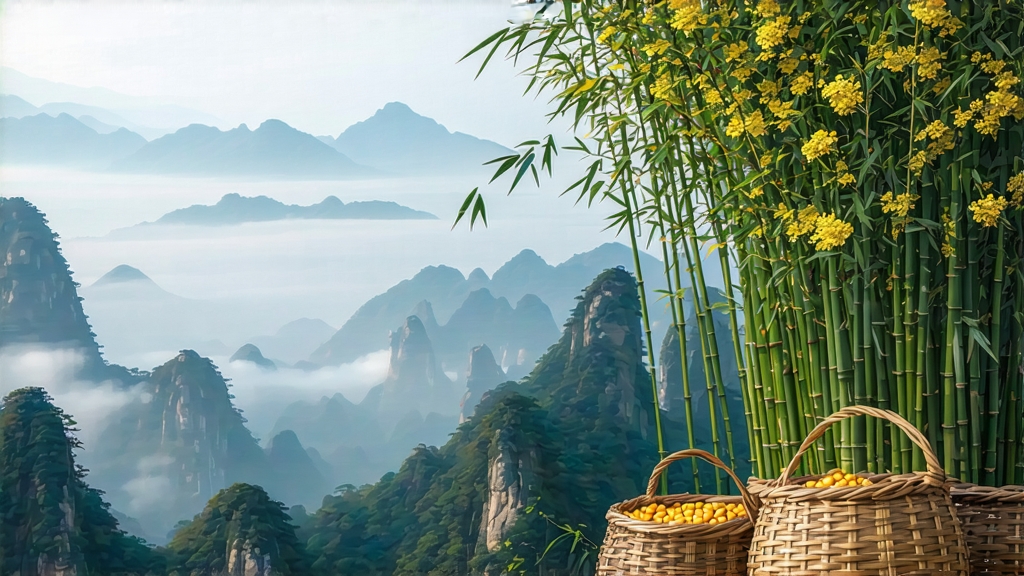
Tucked high in the mist-veiled Dabie Mountains of western Anhui Province, Huoshan Huangya has quietly captivated emperors, poets, and tea aesthetes for more than a millennium. Unlike the better-known green, black, or oolong teas that dominate export statistics, this yellow tea—literally “yellow bud”—occupies a vanishingly small ecological and cultural niche. Annual production seldom exceeds 30 000 kg, most of which is still allocated by pre-order before the Qingming festival. Yet within that scarcity lies a story of dynastic tribute, microscopic withering, and a flavor that suspends time somewhere between fresh spring grass and warm apricot custard. To understand Huoshan Huangya is to witness the slow-motion alchemy that defines the entire yellow-tea category.
-
A leaf born of empire
The first reliable mention appears in the Shennong Bencao Jing (2nd century CE), but the tea’s ascent began under the Tang dynasty when Huoshan county served as a way-station on the imperial courier road. By 763 CE local magistrates were required to forward the earliest buds to Chang’an as “spring tribute.” The Song emperor Huizong—himself a gifted calligrapher—praised the leaf in 1107 for its “jade-yellow liquor that lingers like a hidden melody.” When the Ming court moved to Beijing, the caravan route shifted eastward, yet Huoshan Huangya retained its coveted gongcha (tribute-tea) status for eighteen consecutive reigns. The Qing Qianlong Emperor’s travel diaries record twenty-six separate consignments, each wrapped in yellow silk, the imperial color, and sealed with the dragon seal. Thus the tea acquired a symbolic aura that still clings to every golden bud harvested today. -
Micro-terroir: one mountain, two valleys
Huoshan county straddles 31° N latitude at elevations between 300 and 800 m. The northern slopes absorb the cold air draining off the Dabie massif, while the southern valleys trap humid air from the Yangtze floodplain. The result is a 6–8 °C diurnal swing during early March, slowing respiration and concentrating glutinous rice–like amino acids. Soils are quartz-rich yellow granite loam, pH 5.2–5.6, laced with selenium leached from underlying gneiss. Only three villages—Taiyang, Jinjishan, and Huanggua—possess the original seed-grown tea forests, some bushes topping three meters in age. Farmers speak of “three mists a day”: dawn valley fog, mid-mountain cloud, and evening river steam. Together they filter sunlight into a soft, shifting chiaroscuro that photo-modulates the chlorophyll, edging the leaf toward the pale jade that will later yellow during processing. -
The menhuang miracle
Yellow tea’s defining step is menhuang—literally “sealing yellow”—a controlled post-oxidation that sits conceptually between green tea killing-green and white tea slow withering. In Huoshan the process is still choreographed by a shifu (master) who has apprenticed for at least eight seasons. After plucking one bud and its imminent first leaf (standard 1.8–2.2 cm length) between 5:00 and 7:00 a.m., the leaf is laid in 3 cm layers on bamboo trays for 3–4 h of passive withering. Surface moisture evaporates, but internal turgor remains high. The first low-temperature pan-firing follows at 120 °C for 4 min, just enough to denature polyphenol oxidase without fixing green color. What happens next distinguishes Huoshan Huangya from all other yellow teas: the hot leaf is piled 25 cm deep inside a hemp-lined rattan box, covered with steamed towels, and slid into a charcoal-warmed closet maintained at 28 °C and 75 % RH. For the next 36 h the leaf breathes anaerobically, converting catechins into theaflavins and releasing free amino acids. A faint yellow bloom appears on the bud trichomes; the aroma shifts from cut grass to dried apricot. The shifu tests the pile every 3 h, inserting a forearm to judge temperature and humidity by skin response—no probes, no data loggers. When the core reaches 34